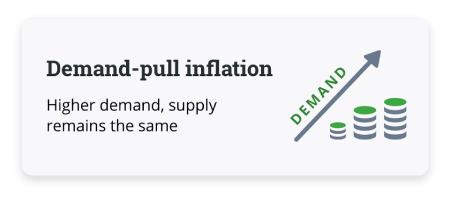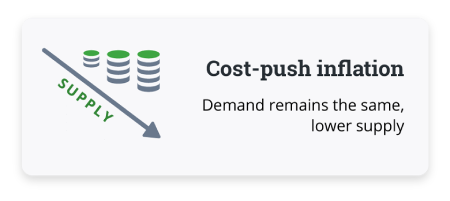Note: The information in this blog is for information purposes only and should not be used or construed as financial, investment, or tax advice by any individual. Information obtained from third parties is believed to be reliable, but no representations or warranty, expressed or implied is made by Questrade, Inc., its affiliates or any other person to its accuracy.
Lesson Understanding inflation
Understanding inflation
Learn more about inflation and it's potential impact to the market.
Do you remember a time when a cup of coffee cost less than a dollar? You might've even heard it from your friends and families when goods were cheaper but now have increased their value.
This is inflation, where the price of goods and services "inflate" or increase over a period of time. Simultaneously, it also indicates the decline in purchasing power of your dollars.
To give a hypothetical example, let’s say the price of a coffee last year was $1.00, but this year it is $1.05. In this instance, your $1.00 doesn’t go as far as buying a cup of coffee anymore and you need an extra 5 cents to buy one. Simplistically, one might say that the 5 cents extra for a cup of coffee is an effect of a 5% inflation rate. But what causes inflation and how can it affect your investments?
What causes inflation?
Inflation happens for various reasons but essentially it occurs when there are changes in the supply and demand in an economy. Typically this falls under two types, demand-pull inflation, and cost-push inflation.

Demand-pull inflation happens when there’s high demand for goods and services but there are no changes in the supply. The higher demand typically comes from economic growth with growing companies and increasing employment and wages. When this happens, people have more confidence in buying, and can lead to buying more than what they could before. But since there’s only enough supply being produced, competition for these supplies (goods and services) increases, and therefore their price increases. Demand-pull inflation often relates to the idea of "too many dollars chasing too few goods”.
To give a hypothetical example, let’s say store XYZ sells laptops directly to consumers and other businesses. After a year of economic growth and employment, more companies and people can now buy laptops and they’re buying them to be more efficient at work. Store XYZ has not made changes to their production of laptops and since the demand for them exceeds what they can produce at the current moment, they increase the price.

Cost-push inflation occurs when there’s an increase in the production cost of goods and services but the demand for it remains the same. Typically as production costs (such as raw materials, land, or labour) increase, companies may not be able to sustain enough quantities for the demand. In order for them to continuously produce, they have to increase their price to compensate for the increased production cost.
Using the same example above, if the cost to make laptops increase (such as semiconductors and labour wages), store XYZ may not be able to produce as much as they wish to. If they wish to continue making laptops, store XYZ has to increase the final price of laptops to compensate for the cost to create one.
How do we measure the rate of inflation?
The inflation rate is typically based on a price average called the consumer price index (or CPI). You can think of CPI as a representative basket that people typically buy on a daily basis. This can consist of clothing, food, transportation, shelter, household utilities, education, and much more. The consumer price index is important as it helps companies adjust their wages and salaries in an environment of constant change in consumer prices. Governments also use CPI to help them adjust pensions payments, tax brackets and help them guide on fiscal policies.
Related lessons
Want to dive deeper?
Inflation & interest
Get a better understanding of how inflation and interest rate risk can affect you.
View lessonRead next
Investing foundations
Understand the fundamentals and major concepts in investing to help you build a solid investing foundation.
View lessonExplore
How to set up financial goals
Discover financial goal setting and how it can impact your investments.
View lesson